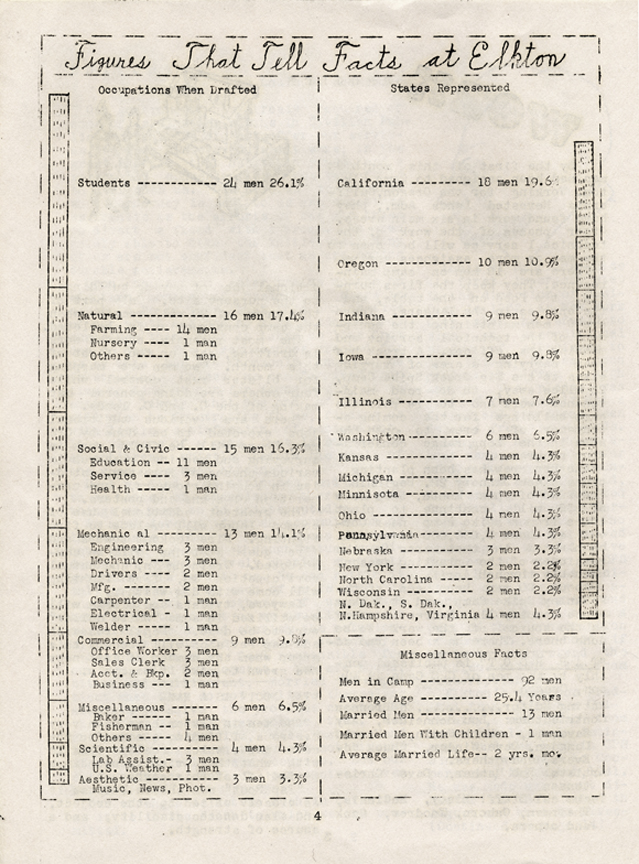- Catalog No. —
- CN 019512
- Date —
- May 2, 1969
- Era —
- None
- Themes —
- Government, Law, and Politics
- Credits —
- Oregon Historical Society
- Regions —
- Portland Metropolitan
- Author —
- Unknown
Tap Root, Figures that Tell Facts at Elkton
After Japan attacked Pearl Harbor on December 7, 1942, most Oregonians approved of the United States' entry into the Second World War, but support was not unanimous. Across the United States, twelve-thousand religious conscientious objectors (COs) participated in the Civilian Public Service (CPS) program, which offered drafted men civilian work of national importance as an alternative to service in the military conflict. Tap Root was a monthly publication written by COs who were assigned to CPS Camp 59 in Elkton, Oregon. The two pages featured here describe the diversity of camp assignees and the physical environment of the camp.
The CPS program had its roots in the Selective Service and Training Act of 1940. Members of the "historic peace churches," the Church of the Brethren, the Religious Society of Friends (Quakers), and the Mennonite Church, pushed for the bill as the war in Europe escalated and the likelihood of U.S. involvement increased. Although the peace churches did not succeed in securing a complete exemption for absolutists, a provision that would have appealed to each of the forty-three thousand CO's in the United States during World War II, the law provided religious CO's the legal right to avoid direct military participation by means of non-combatant military service or civilian work of national importance.
The CPS program lasted six years. Church groups administered the camps and, by the end of the war, had spent nearly seven million dollars on the project. Civilian government agencies, including the Forest, National Park, and Soil Conservation services, organized work programs for inductees. The Selective Service transported program participants to the camps and oversaw program operations. Inductees did not receive pay for their work.
Civilian Public Service Camp 59 became a CPS camp in November 1942, taking over a former Civilian Conservation Corps (CCC) facility, Camp Elkton. The camp was under the technical supervision of the General Land Office, Oregon and California Administration, and it was sponsored by the Friends Service Committee. Work at the camp was primarily a continuation of the forest conservation projects started by the CCC, including reforesting cutover lands, road construction, surveying public lands, forest fire prevention, and forest fighting.
Further Reading:
Justice, Joyce. "World War II Civilian Public Service" Conscientious Objector Camps in Oregon." Prologue 1991 23(3): 266-273
Davis, Charles and Jeffrey Kovac. "Confrontation at the Locks: A Protest of Japanese Removal and Incarceration during World War II." Oregon Historical Quarterly 107 (4): 486-509.
Barber, Katrine and Eliza Elkins Jones. "The Utmost Human Consequence: Art and Peace on the Oregon Coast, 1942-1946." Oregon Historical Quarterly 107 (4): 510-535.
Written by Sara Paulson, © Oregon Historical Society, 2007.
